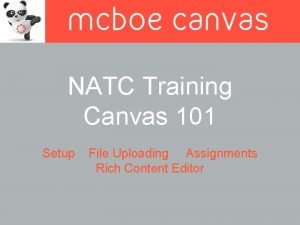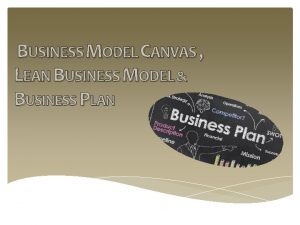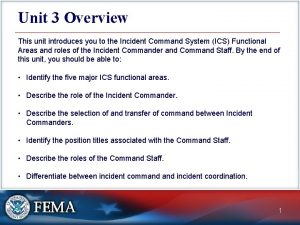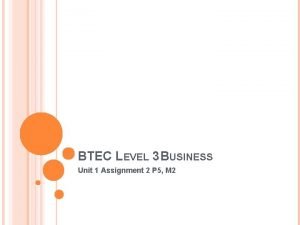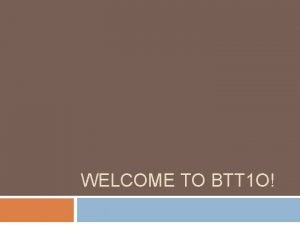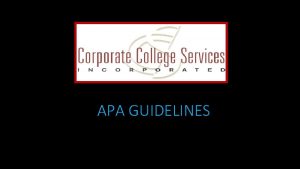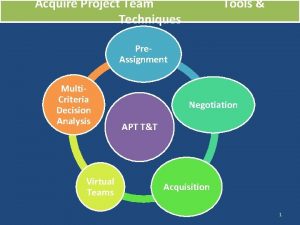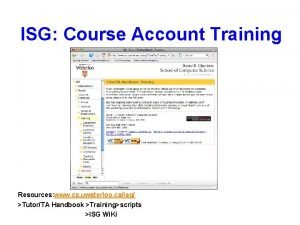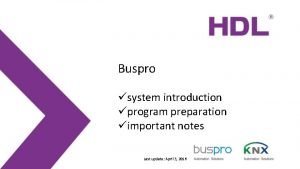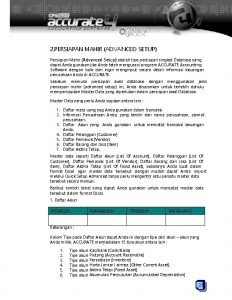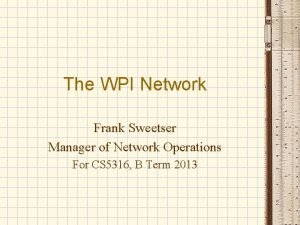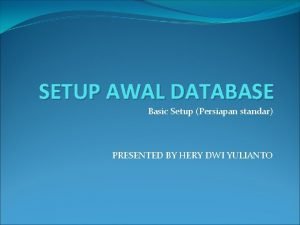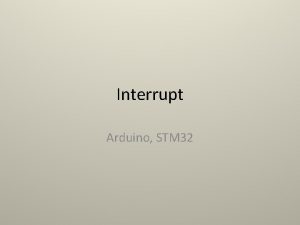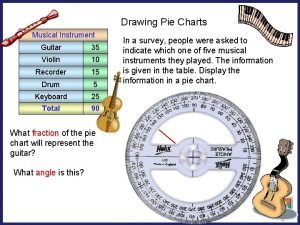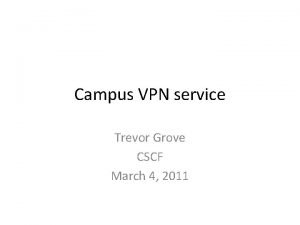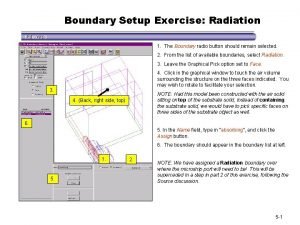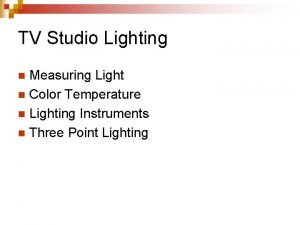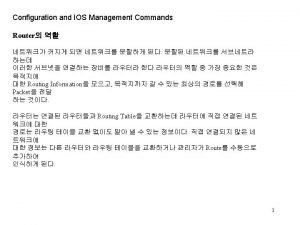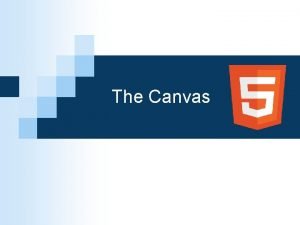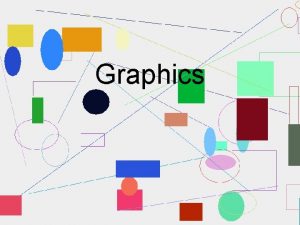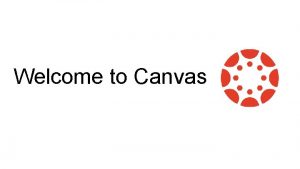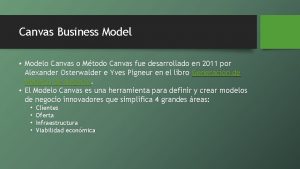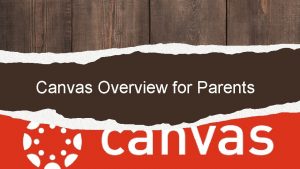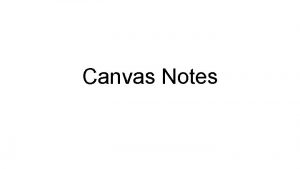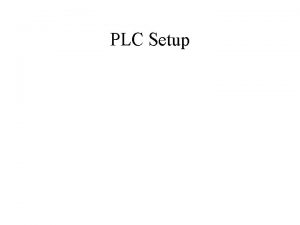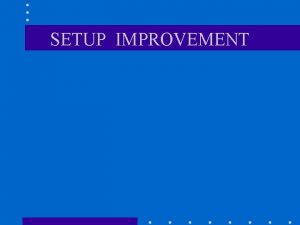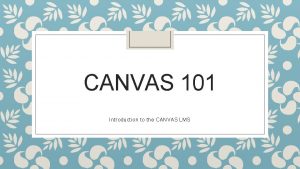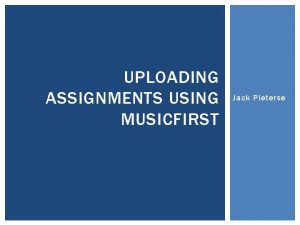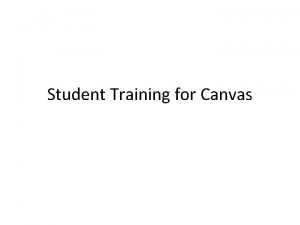NATC Training Canvas 101 Setup File Uploading Assignments





































































































- Slides: 101

NATC Training Canvas 101 Setup File Uploading Assignments Rich Content Editor

Setting Up Your Course New course? Use the setup checklist to help you get started.

Use to import content from other learning management systems like Blackboard and Moodle

Use to import content from other learning management systems like Blackboard and Moodle You don’t have to enroll students. Canvas will even take care of transfer students, but if you ever need to manually add someone, here’s how.

Use to import content from other learning management systems like Blackboard and Moodle Drag and drop to change the order of the links on the left side of your course, or disable them from student view altogether! You don’t have to enroll students. Canvas will even take care of transfer students, but if you ever need to manually add someone, here’s how.

Use to import content from other learning management systems like Blackboard and Moodle Drag and drop to change the order of the links on the left side of your course, or disable them from student view altogether! You don’t have to enroll students. Canvas will even take care of transfer students, but if you ever need to manually add someone, here’s how. Change the appearance of your page. You can set it to show an activity stream, the list of course modules, a syllabus, or a custom page

Use to import content from other learning management systems like Blackboard and Moodle Drag and drop to change the order of the links on the left side of your course, or disable them from student view altogether! Field trip? Picture day? Add events to your class calendar You don’t have to enroll students. Canvas will even take care of transfer students, but if you ever need to manually add someone, here’s how. Change the appearance of your page. You can set it to show an activity stream, the list of course modules, a syllabus, or a custom page

To get a preview of what your course will look like to students, click on “Settings, ”

and then select “Student View” To get a preview of what your course will look like to students, click on “Settings, ”

Uploading Files Once you’ve set up your course, upload the files you want to include here

Uploading Files Once you’ve set up your course, upload the files you want to include here It’s grey because you have not uploaded files yet, so it’s not visible to your students. Once you upload files, the link will appear active for your students.

You can click here to browse to your files and upload them to the course folder Or you can create different folders within the course and add your files to them.

You can click here to browse to your files and upload them to the course folder Or you can create different folders within the course and add your files to them.

Adding Assignments Add an assignment to your course by selecting “Assignments, ”

Adding Assignments Add an assignment to your course by selecting “Assignments, ” and then clicking the “+ Assignments” button.

Give it a name

Give it a name Use the text tools and content editor tools to add instructions for your assignment. You can embed images and videos, add hyperlinks, tables, math equations. . even a video of yourself! Hover the icons to see what they are.

Enter the number of points the assignment will be worth and select how you would like the grade to be displayed.

Select whether you want the students to submit their work online, on paper or not at all. If you choose online, enter the format: text (students type directly into Canvas), website URL (enter a web address), media recording (film their response) or file upload.

Enter the due date, and the dates you want the assignment to be available for your class. If the assignment is complete, click “Save and Publish” to make it visible to the students. If you still need to work on it, just click “Save. ”

NATC Training Canvas 201 a Rubrics Question Banks Quizzes Speed Grader

Rubrics where we walk through one, then you take a stab at your own

1 - Start with the Outcomes menu on the left 2 - From here you will find the option to Manage Rubrics on the far right of the Outcomes screen

Since you don’t yet have any rubrics, just click to Add Rubric. If you did have any, you could find them and edit them from this screen.

1 - Name the rubric 2 - Modify the description of your criteria/criterion 3 - Add additional criterion 4 - Link to outcomes (let’s talk) 5 - Adjust ratings 6 - All finished

Name the rubric something descriptive, but if you don’t get too specific you can reuse rubrics for different assignments. I’m not going to follow my own advice, here.

Once you have it named, begin adjusting your criteria and your ratings. The total points will move with you. You can change these, but Canvas will distribute them evenly by default. Outcomes are a special case that we should talk about here.

When you are finished you will be taken back to the Course Rubrics page and see any rubrics you have (including whatever you just added). Notice that you get more than just the title (useful when you use brilliant names like “Essay Rubric 1” and “Essay Rubric 2”).

Now try it on your own. You are already at the rubrics page, so make one that you can use later. Try to add four or five criteria and more than the default two ratings.

Rubrics ?

Now try it on your own. You are already at the rubrics page, so make one that you can use later. Try to add four or five criteria and more than the default two ratings.

Quizzes where we walk through the options, then you make on your own

1 - click Quizzes from the left-hand menu 2 - add a quiz with the + Quiz button

the first screen gives you all the options to setup OTHER than the content (so format is the first tab, questions are on the second)

this screen allows you to add questions to the quiz

here you have the formats for the questions. . . and they are substantial, so it is more useful to walk through one

Quizzes ?

remember to start here and try creating your own quiz

Question Banks where we show you how to reuse and randomize your questions, then you add a few of your own for later use in quizzes

1 - click Quizzes from the left-hand menu 2 - this time, use the gear beside the + Quiz button

add a new question bank from here (or view/edit existing banks once you have some)

the options on the right are to manage banks quickly, but the same options are available later when you click the name of the bank (notice it is a link)

1 - add a question, just like from a quiz 2 - change the name 3 - if you had more than one question to put in this bank (this can be super helpful) 4 - hmmm 5 - if you have them, this option lets you connect them (esp. good for analytics and RTI)

Question Banks ?

now make your own. . . remember that by putting questions in a bank, you can automate lots of your quizzes later, so even if you make a bank of 10 now you won’t have to start over later when you want a 20 question quiz (or 5, or whatever)

Speed Grader for this segment you’ll really just have to watch (it won’t make much sense without some student submissions to work with)

NATC Training Canvas 201 b People Groups Discussions Feedback Modules Grade books E-Portfolios (a special case)

People a look at how to find analyze student activity within a course (data here are static, but we will look at some “live”)

the People link is a bit like a roster for your course, but there is FAR more available to you than just a list of names

here is an example of a course with two teachers and no students (notice the +Group Set button. . . we’ll come back to that later)

This is a snippet of the HGHS faculty course used for our faculty meetings. A couple of things to notice are the dates and the times.

Here is an excerpt from a Spring 15 class at HGHS. Again, notice the times. We will go ahead an click on one of the student names.

Here is the opening screen for the User Account Details page. You have a number of interesting options on the right, plus “more user details. . . ” at the bottom. Let’s look at the “more user details. . . ”

We get a list of other courses, plus some login information. Go to Analytics on the top right.

This is a small piece of static data. If we take a look at the real data in Canvas they show us far more detail.

If we go back to the user’s detail and click Grades, we get something like this. This particular piece is nice to offer up when mom doesn’t know why Johnny is doing so poorly. So is the next piece, the Access Report.

1 - links to the actual pages visited 2 - time-stamp of the page visit 3 - number of minutes spent on that page 4 - your downloadable record, should you want it

People ?

Groups creating groups within a course

from the People menu, you’ll see both +Group Set and View User Groups

first you must name your group set (I tend to do this based on the assignment; you’ll name the groups of students later) you have some options here

if you choose to automatically split students you have the option for “Leadership” Save your set

once you have a group set (mine here is the tab called “Project Groups”) you have to add groups to the set (+Group on the right)

now name the groups (by table, by row, by book. . . I guess whatever, but the students will see this, so don’t make “turtles” and “cheetahs”)

once you have groups created it is just a matter of dragging and dropping into the correct group

Here’s why we went to all that trouble. When you create a new assignment, one of the options is to make it a Group Assignment. Why, yes, I would like to give everyone the same grade (or not). No, I do not need 51 copies of the project if there are only 10 groups.

Groups ?

Discussions how to use Canvas to hold a discussion and the options provided

Discussions (from the Discussion menu) are a way to organize student responses or group communication (if you allow). You can control some of the delivery and choose to grade them or not.

before anything else, consider the options you have some of these might depend on you, the class, the grade level, etc. you can change these per topic/discussion if you want

in addition to the topic and the RTE, there are some options here that changed as you choose them

Not to dissuade you, but I use discussions far less than I anticipated. Make sure that if you have a discussion, it really requires them to discuss it with EACH OTHER, not just you. If you want them to discuss something with you, this is really not the best (or even a good) way to do it.

Discussions ?

Feedback some of the great ways Canvas allows feedback so your students can see / hear / read what you think about their assignments

Feedback this is so much better in person, so instead of static slides, I want you to see it in action (and hear it, etc. )

Feedback ?

Modules another way to handle the organization of your assignments and some automation tips for timing and pacing

you’ll find the Modules menu on the left if you have experience with Moodle, you may love this you might have to train students to use this

1 - make a new module (just the container, not the contents) 2 - add contents to the module 3 - publish the module (separate from the contents) 4 - due dates for each piece of the module 5 - point value for each piece of the module 6 - individual publishing and editing options

1 - type of content to add to your module 2 - don’t have it yet? here’s a shortcut 3 - existing content of your selected type 4 - visual organization (my experience was mixed)

now go back to the Modules menu and try making your own create the module, add a couple of assignments, change due dates, etc.

Modules ?

Grade book where the results live and how you might make Canvas and INOW/Chalkable play nice(r) together

you’ll find the Grades menu on the left to head off the number 1 question: no, INOW will not import these grades. . . but we have another solution (at the end)

1 - working with sections or cross-listings 2 - options for the grade book (more later) 3 - running average (you can move this column as I have here) 4 - grades as x/x 5 - grades as % green - no submission, no grade blue - late submission, no penalty (between “late” and “until”) ungraded submissions not show (I don’t have any, but I can show you)

Grade book options, some for viewing ease, some for grading ease

Speed. Grader takes you to that application Download Submissions gives you a local copy of all submissions Mute Assignment “mutes” notifications all the others are on the following slides

this is the Assignment Details window *I THINK* the boxes at the top are (left-to-right) on time, late, unsubmitted

Message students who. . . this is one of my favorite pieces of Canvas, as it automates reminders, + and - feedback, and TRACKS that communication for you

I’ve never used this, but it could be a way to almost mimic INOW’s “Fill All” option. Just set the default grade and don’t check the box. All ungraded assignments will get filled in with the supplied score.

this is a nice, visual way to adjust curves when you want them if you change your mind, you will have some work ahead of you, so be sure when you do it you really want it done

and THIS is one way to make INOW work (warning: it isn’t elegant, but it is a decent compromise)

Grade book ?

E-Portfolios a special case in Canvas, where the content exists outside of all courses

E-Portfolios left menu is within a course top menu is “global” or within an account e. Portfolios can pull content from all your courses, but save them outside so you can access them after a course sunsets (good and bad)

since e. Portfolios are part of the user’s account, not the course, click on your name at the far top-right

your last option on the left menu is now called “e. Portfolios”

on the far right you have the option to create a new e. Portfolio (you will be asked if you want to make it public when you name it)

from your list of all e. Portfolios, click the name of the one you want to view and/or edit

let’s go to an e. Portfolio and look at these pieces

Finally ?
 File-file yang dibuat oleh user pada jenis file di linux
File-file yang dibuat oleh user pada jenis file di linux Mcboe inow
Mcboe inow Lean model canvas vs business model canvas
Lean model canvas vs business model canvas Physical image vs logical image
Physical image vs logical image Fungsi sistem file
Fungsi sistem file Remote file access in distributed file system
Remote file access in distributed file system An html file is a text file containing small markup tags.
An html file is a text file containing small markup tags. In a file-oriented information system, a transaction file
In a file-oriented information system, a transaction file Establish objectives, make assignments, and order resources
Establish objectives, make assignments, and order resources What are tiered assignments
What are tiered assignments Economic naturalist writing assignment
Economic naturalist writing assignment Gpp3o assignments
Gpp3o assignments Hpc3o assignments
Hpc3o assignments Tiered assignments examples
Tiered assignments examples User rights assignments
User rights assignments Cln4u assignments
Cln4u assignments Btec level 3 business unit 1
Btec level 3 business unit 1 Unit 1: exploring business assignment 3 examples
Unit 1: exploring business assignment 3 examples Hsb4u assignments
Hsb4u assignments Btt1o
Btt1o Excel homework assignments
Excel homework assignments Avid assignments
Avid assignments Bongo video assignments
Bongo video assignments Nick parlante
Nick parlante Ncrq hsd2 assignment 1
Ncrq hsd2 assignment 1 Uts referencing guide apa
Uts referencing guide apa Color wheel assignment
Color wheel assignment Strategic hr issues in global assignments
Strategic hr issues in global assignments Apa homework format
Apa homework format Acquire resources tools and techniques
Acquire resources tools and techniques Ksu ccse tutoring
Ksu ccse tutoring Selection criteria for international assignments
Selection criteria for international assignments Undefined topic assignment
Undefined topic assignment They haven't finished their homework yet
They haven't finished their homework yet Software engineering lab assignments
Software engineering lab assignments Hadoop assignment help
Hadoop assignment help Ihrm objectives
Ihrm objectives Strategic hr issues in international assignments
Strategic hr issues in international assignments Ems grade 9 business plan
Ems grade 9 business plan Cgc1p assignments
Cgc1p assignments Sculpture assignments
Sculpture assignments Ms studies chapter 1
Ms studies chapter 1 Information and communications university zambia
Information and communications university zambia Unit 8 ecommerce p2
Unit 8 ecommerce p2 Scos skyward
Scos skyward Weight training 101
Weight training 101 Procurement 101 presentation
Procurement 101 presentation Fiu vendor registration
Fiu vendor registration Ap automation 101
Ap automation 101 Medicare 101 training
Medicare 101 training Managed care 101 training
Managed care 101 training Void loop
Void loop Untangle vpn setup
Untangle vpn setup Leica total station setup and operation
Leica total station setup and operation Shaw vpn
Shaw vpn Multi camera production
Multi camera production Fahrenheit 451 study questions
Fahrenheit 451 study questions Realsoft 11.6 download
Realsoft 11.6 download Trimble snb900 repeater setup
Trimble snb900 repeater setup Polycom vc equipment
Polycom vc equipment Paramount light
Paramount light Nasp archery range setup
Nasp archery range setup Bios de american megatrends
Bios de american megatrends Lpk setup
Lpk setup Boston scientific latitude setup
Boston scientific latitude setup Surface hub admin guide
Surface hub admin guide Marmoset waterloo
Marmoset waterloo Toast meraki router
Toast meraki router How do you play checkers
How do you play checkers Drug resistance training
Drug resistance training Setup time and hold time in digital electronics
Setup time and hold time in digital electronics Emt setup
Emt setup Basic manicure steps milady
Basic manicure steps milady Cxurn setup meaning
Cxurn setup meaning Hdl buspro protocol
Hdl buspro protocol Arduino副程式
Arduino副程式 Perbedaan persiapan standar dan persiapan mahir
Perbedaan persiapan standar dan persiapan mahir Winlink express
Winlink express Video conferencing system setup
Video conferencing system setup Ue4 vehicle movement
Ue4 vehicle movement Wpi wifi setup
Wpi wifi setup Cornell notes setup
Cornell notes setup Apa does title page have page number
Apa does title page have page number Backlighting setup
Backlighting setup O365 hyatt mail
O365 hyatt mail Persiapan standar adalah
Persiapan standar adalah Vbcable_setup
Vbcable_setup Science logbook example
Science logbook example Interrupt setup arduino
Interrupt setup arduino $windows. bt sources panther
$windows. bt sources panther Purpose of hmailserver
Purpose of hmailserver Gmaw set up
Gmaw set up Guitar setup worksheet
Guitar setup worksheet Virtualbox windows xp image download
Virtualbox windows xp image download Gv black formula
Gv black formula Cyclic voltammetry setup
Cyclic voltammetry setup Waterloo vpn
Waterloo vpn Setup exercise
Setup exercise Tv studio lighting setup
Tv studio lighting setup How to write a logbook for a science project
How to write a logbook for a science project Roku account setup
Roku account setup Setting up trays and trolleys ppt
Setting up trays and trolleys ppt

